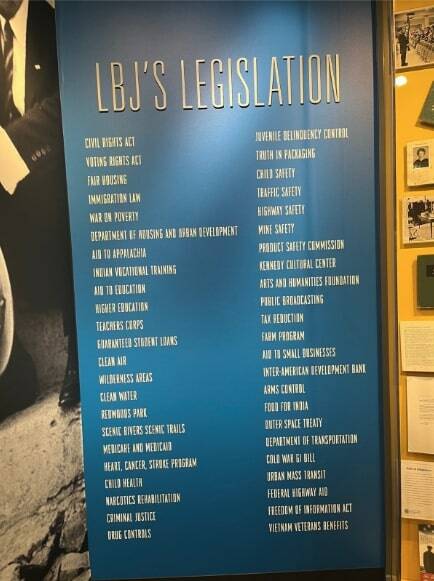My flight home from Logan airport was scheduled for 7 p.m. But after a glorious girlfriend weekend exploring Boston, my friend needed to drive back to her home. I’d be on my own for the rest of the day.
“If you drop me at the Kennedy presidential library, I’m sure I can kill a few hours there,” I told my girlfriend. Little did I know a few hours would be barely enough.
In a presidential election year, huge conventions for the Republican and Democratic parties give prime spots to former presidents and luminaries from past campaigns. But Gen Z’s, some of whom will be voting for the very first time in November, couldn’t possibly remember the policies and accomplishments, let alone the challenges and controversies that plagued former presidents, especially those who go way back to before they were born. You know, like 30 years ago! Outside of history class, how are former presidents remembered, and how much control do they have over their legacy?
Enter presidential libraries. These are not lending libraries. There is no children’s section. There’s certainly no fiction or science fiction section. These libraries take you back in time for a glimpse at the setting, the time, the clothes, the music, the feel of what was going on during a
particular president’s tenure. Most have a reproduction of the Oval Office, decorated exactly as it was during that president’s term. Four of them — Richard Nixon’s, Bill Clinton’s, and George H.W. Bush’s and George W. Bush’s — even let you sit at the Resolute Desk!
Fifteen years ago, on a business trip to Austin, Texas, I visited the Lyndon Baines Johnson Presidential Library and Museum. I didn’t know much about him, having been in 3rd grade when Johnson became the President, and 9th grade when his term ended. As a 10th grader, I’d gotten my first volunteer job at a Head Start Center in the basement of a housing project in Brooklyn. But until I visited the LBJ library, I didn’t realize that it was Johnson, a former teacher, who’d created Head Start, indirectly influencing my path into a 42-year career in social work.
This spring, my husband, son, future daughter-in-law, and I took a family vacation in Austin. As we planned our trip, I said, “We’ve got to visit the LBJ library,” hoping they’d all get as much out of it as I had on my first visit. The four of us chose to wander around on our own, each lingering at the exhibits that most spoke to our unique interests. When we reconvened a few hours later, everyone was smiling. Yay! And they each had a particular story to tell about what had spoken to them most about the 36th president.
Although only eight years old when Kennedy was assassinated, I have vivid memories of that shocking day. But I knew very little about Kennedy’s political rise, his status as a war hero, the context in which the Civil Rights Movement burst on the scene. Over four hours at his library, some of the gaps in my knowledge were filled. In one diorama, a black and white TV set plays Harry Belafonte campaigning on Kennedy’s behalf. Right next to the TV is a table lamp exactly like the one from my parent’s 1960s home. Tears streamed down my face as I remembered dancing around our living room to Belafonte’s Banana Boat song. The life-sized mannequins with Jacqueline Kennedy’s dresses, hats, handbags and accessories mesmerized me, as I pictured my late mother, dressed in similar gowns, going out for New Year’s Eve or other special occasions. Lost in nostalgia, I barely realized what time it was, and had to rush to the airport to catch my plane home.
Most presidents begin planning their library while still in office, because that’s when they have the biggest platform and the most clout. No federal property, and no federal funds may be used. Instead, a nonprofit organization must be formed to raise the millions of dollars needed to purchase land, design a building, etc. Roosevelt, Eisenhower, Johnson, and Reagan all started planning, and even breaking ground before their terms ended. Barak Obama left office in January 2017, and his South Side of Chicago library isn’t scheduled to open until Spring of 2026.
The National Archives and Records Administration (NARA) says there are no plans for a physical Trump Library, though NARA administers a website about his presidency.
The only two presidential libraries west of the Rockies are Richard Nixon’s in Yorba Linda, one hour southeast of Los Angeles, and Ronald Reagan’s in Simi Valley, 70 miles east of Santa Barbara. I’d love to visit these two Southern California sites. Who could resist the chance to see Richard Nixon shaking hands with Elvis Presley?
Meanderings is a travel column by Mindy Stern, a Mercer Island resident whose essays can be found at www.mindysternauthor.com.



